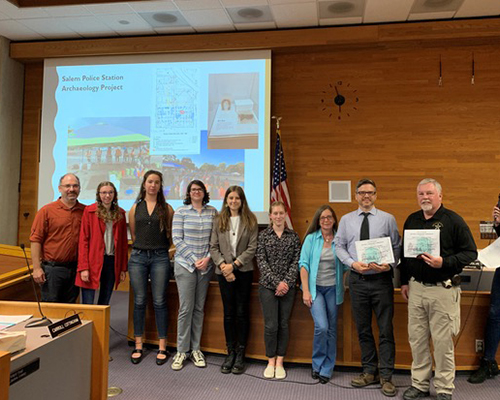The Mill Stream that runs through campus is more than a great place to relax on a sunny day. It’s part of a network of waterways that once served as the lifeblood for Salem’s textile industry, and Willamette student researchers uncovered clues about the history of one such channel in a geoarchaeology class this past semester.
On May 16, the Salem Historic Landmarks Commission presented the Virginia Green Award to the students for their research at the downtown construction site of the new Salem Police Station. The award recognizes exemplary service on behalf of historic preservation.
“Receiving an award for the work we conducted on the site feels very surreal,” said Allison Davies ’19, a history and environmental science major. “To me, it’s indicative of the amount of hard work we all put into the project. It feels pretty good to be recognized for that.”
An extensive excavation of the site in 2018 uncovered more than 17,000 artifacts, including precontact Native American tools, 19th-century ceramics, bottles, buttons and shoes. Students in professor Scott Pike’s “Research in Geoarchaeology” class used a different set of tools to examine the area’s past.
One study shed new light on a portion of a millrace that used to run from Mill Creek beneath Division Street to a factory on River Road. Students relied on ground penetrating radar in a quest to determine the previous location of the waterway, which had been abandoned, covered and largely forgotten.
“They found excellent evidence of the course for the old millrace,” Pike said.
Another team used a portable X-ray fluorescence spectrometer to assess the composition and age of ceramics and glass at the site. Students also researched the formation of a levee that abuts Mill Creek and analyzed soils to determine how the landscape was shaped and managed over time.
Elena Familetto ’19, who’s planning to pursue a career in digital archaeology, said the skills she developed at the site will translate directly to her profession.
“This class gave me hands-on experience using some of the field and lab methods I'll need in the future,” said Familetto, an environmental science and archaeology major. “And getting to work with the tribes, city officials, and archaeology and construction companies involved with the project really helped me contextualize the whole process of archaeology in an urban setting.”
The students shared the award with the city of Salem and AINW, a Portland archaeology firm. The collaborative effort demonstrates Willamette’s connection to the broader community, Familetto said.
“It’s great when classes work in the community to become part of something outside the classroom,” she said. “I hope this paves the way for more students to get involved with other projects in the area.”

